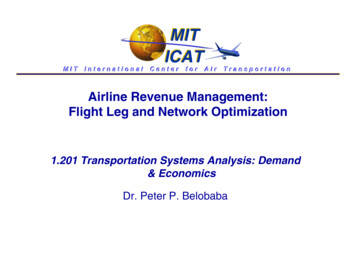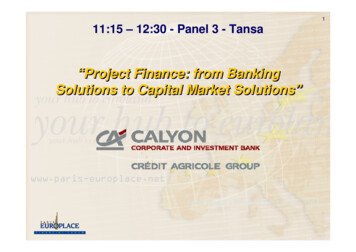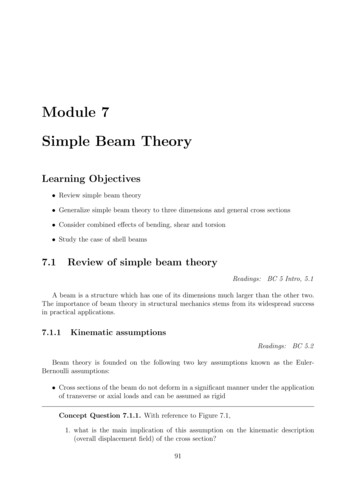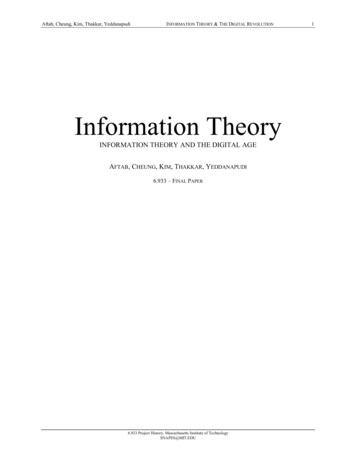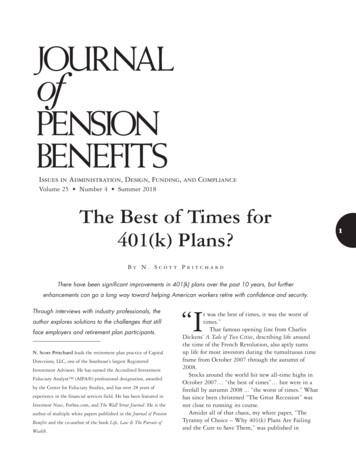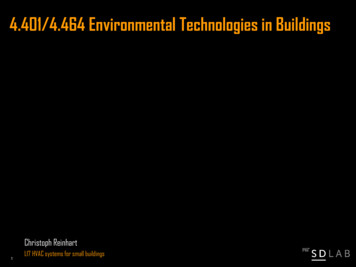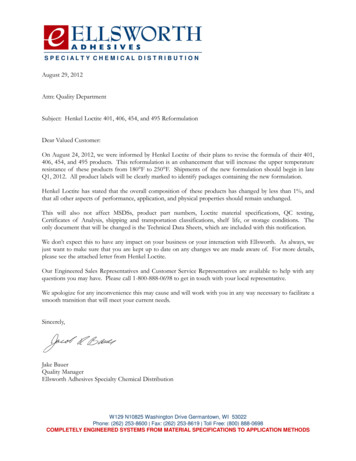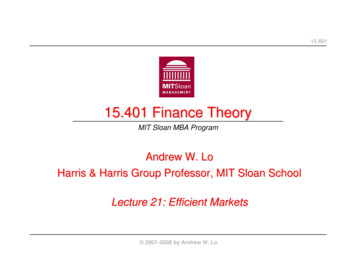
Transcription
15.40115.401 Finance TheoryMIT Sloan MBA ProgramAndrew W. LoHarris & Harris Group Professor, MIT Sloan SchoolLecture 21: Efficient Markets 2007–2008 by Andrew W. Lo
Critical Concepts 15.401MotivationPowers of ObservationBehavioral vs. RationalThe Triune Model of the BrainThe Adaptive Markets HypothesisConclusionReadings Lo (2005, 2007)Lecture 21: Efficient Markets 2007–2008 by Andrew W. LoSlide 2
Motivation15.401Theory of Market Efficiency: No Free Lunch, No Arbitrage Prices Fully Reflect All Available Information Prices Follow Random Walks Trade-Off Between Risk and Expected Return “Active” Management Does Not Add ValueLecture 21: Efficient Markets 2007–2008 by Andrew W. LoSlide 3
Motivation15.401Courtesy of Elsevier, Inc., http://www.sciencedirect.com. Used with permission.Lecture 21: Efficient Markets 2007–2008 by Andrew W. LoSlide 4
Motivation15.401January 28, 1986, 11:39am 11:47am: ‘‘Space ShuttleExplodes’’ 12:17pm: ‘‘Lockheed HasNo Immediate Comment’’ 12:52pm: ‘‘Rockwell IntlHas No Comment’’This photograph was created by NASA and is in the public domain.Lecture 21: Efficient Markets 2007–2008 by Andrew W. LoSlide 5
Motivation15.401 Reagan Establishes Presidential Commission To Investigate Source unknown. All rights reserved. This content is excludedfrom our Creative Commons license. For more information,see http://ocw.mit.edu/fairuse .Lecture 21: Efficient Markets 2007–2008 by Andrew W. LoSlide 6
Motivation15.401Rogers Commission Report Published June 9, 1986 Concluded that Morton Thiokol was at faultO-RingAft Systems Tunnel with E&I CablesForward Systems Tunnelwith E&I Cables and RSS Destruct LSCSeparation Ring (Ordnance Ring)Igniter (SRM)Frustum (Internal Cables)Solid Rocket MotorNozzle ExtensionAft Skirt Feed Thru(Rooster Tail)Aft Center RocketMotor SegmentThrust Vector Control(TVC) Systems(Interior of Skirt)Nose CapAft SkirtDrogue and Pilot ParachutesForward Booster Separation Motors (4)Main Parachute Support Structurewith Three Main ParachutesForward RocketMotor SegmentAft BoosterSeparation Motors (4)Forward CenterRocket Motor SegmentAft Skirt CablesCables in ETA Ring andAft IEA with CoversForward Skirt and Forward IEAET/SRBStrutsImage by MIT OpenCourseWare.Lecture 21: Efficient Markets 2007–2008 by Andrew W. LoSlide 7
Motivation15.401 The Stock Market Reflected This Information Within MinutesCourtesy of Elsevier, Inc., http://www.sciencedirect.com. Used with permission.Lecture 21: Efficient Markets 2007–2008 by Andrew W. LoSlide 8
Motivation15.401Courtesy of Elsevier, Inc., http://www.sciencedirect.com. Used with permission.Lecture 21: Efficient Markets 2007–2008 by Andrew W. LoSlide 9
Motivation15.401Behavioral Finance: Market Participants Are Irrational Cognitive and Behavioral Biases– Loss Aversion, Anchoring, Framing– Overconfidence– Overreaction– Herding– Mental AccountingLecture 21: Efficient Markets 2007–2008 by Andrew W. LoSlide 10
Powers of Observation15.401Still image removed due to copyright restrictions. See the video here: profsimons. "Selective Attention Test."March 10, 2010. YouTube. Accessed October 15, 2010. http://www.youtube.com/watch?v vJG698U2Mvo.Lecture 21: Efficient Markets 2007–2008 by Andrew W. LoSlide 11
Behavioral Vs. Rational15.401Patient Elliot Had Frontal Lobe Damage: No Impact on IQ or Logical Functions– Perceptual Ability– Past MemoryBook cover image removed due to copyright restrictions:Damasio, Antonio. "Descartes' Error: Emotion, Reason,– Short-Term Memoryand the Human Brain." New York, NY: Harper Perennial,1995. ISBN: 9780380726479.– Learning– Language– Arithmetic But Behavior Was Quite Irrational!Lecture 21: Efficient Markets 2007–2008 by Andrew W. LoSlide 12
Behavioral Vs. Rational15.401Damasio (1994, p. 36):When the job called for interrupting an activity andturning to another, he might persist nonetheless,seemingly losing sight of his main goal. Or he mightinterrupt the activity he had engaged, to turn tosomething he found more captivating at that particularmoment The flow of work was stopped. One mightsay that the particular step of the task at which Elliotbalked was actually being carried out too well, and atthe expense of the overall purpose. One might say thatElliot had become irrational concerning the larger frameof behavior HarperCollins Publishers. All rights reserved. This content is excluded from our Creative Commons license.For more information, see http://ocw.mit.edu/fairuse.Lecture 21: Efficient Markets 2007–2008 by Andrew W. LoSlide 13
Behavioral Vs. Rational15.401No Reaction to Emotional Stimuli: “to know, but not to feel.”Impaired Emotional Response IrrationalitySerious Implications For DecisionmakingWhat Do We Mean By Rational?Left Brain/Right Brain DistinctionLecture 21: Efficient Markets 2007–2008 by Andrew W. LoSlide 14
The Triune Model of the Brain15.401Hominid BrainCerebrum(Neo cortex or new brain)Limbic system(Mammalian or mid brain)Reptilian complex(Old brain)Mammalian BrainCorpus callosumCerebellumBrain stemReptilian BrainImage by MIT OpenCourseWare.Lecture 21: Efficient Markets 2007–2008 by Andrew W. LoSlide 15
The Triune Model of the Brain15.401Examples of Applications: Forced Smile vs. Natural Smile Social Rejection vs. Physical PainEmotional Stimulus Can Short-Circuit Hominid Brain “The Gift of Fear”, G. de Becker Too Flustered To SpeakLecture 21: Efficient Markets 2007–2008 by Andrew W. LoSlide 16
The Triune Model of the Brain15.401Say the colors of the following LEPINKBLACKBLUEYELLOWGREENLecture 21: Efficient Markets 2007–2008 by Andrew W. LoSlide 17
The Triune Model of the Brain15.401Say the colors of the following LEPINKBLACKBLUEYELLOWGREENLecture 21: Efficient Markets 2007–2008 by Andrew W. LoSlide 18
The Triune Model of the Brain15.401Preferences Are Produced By The Three Brains Logical Reasoning Produced by Hominid Brain Emotional Stimulus Overrides Hominid Brain Preferences May Not Be Stable Over Time Preferences May Not Be Stable Over Circumstances What Are Your Ultimate Objectives? Will Your Actions Help Or Hinder You?Lecture 21: Efficient Markets 2007–2008 by Andrew W. LoSlide 19
The Adaptive Markets Hypothesis15.401Biological, Not Physical, View of Markets:1. Individuals Act In Self-Interest2. Individuals Make Mistakes3. Individuals Learn and Adapt4. Competition Drives Adaptation and Innovation5. Natural Selection Shapes Market Ecology6. Evolution Determines Market DynamicsLecture 21: Efficient Markets 2007–2008 by Andrew W. LoSlide 20
The Adaptive Markets Hypothesis15.401Simon’s Notion of “Satisficing”: Heuristics, Not Optimization Develop Mental Models To Simplify Decisions Learning Is A Key Evolutionary Adaptation Cost: Leads To Certain Biases And Regularities How Do We Know Where To Stop Optimizing?Answer Evolutionary ForcesLecture 21: Efficient Markets 2007–2008 by Andrew W. LoSlide 21
The Adaptive Markets Hypothesis15.401Where Do Heuristics Come From? Consider the Problem of Getting Dressed Wardrobe: 5 Jackets, 10 Pants, 20 Ties, 10 Shirts, 10 Pairs of Socks,4 Pairs of Shoes, 5 Belts 2,000,000 Possible Outfits! Suppose It Takes 1 Second To Evaluate Each Outfit How Long Will It Take To Get Dressed? 23.1 Days!How Do We Get Dressed So Quickly?Lecture 21: Efficient Markets 2007–2008 by Andrew W. LoSlide 22
The Adaptive Markets Hypothesis15.401Practical Implications: Risk/Reward Relation Not Stable (Nonlinear) Risk Premia Are Time-Varying Limited Arbitrage Exists From Time To Time Strategies Wax And Wane Adaptation and Innovation Are Keys To Survival Survival Is All That Matters!Lecture 21: Efficient Markets 2007–2008 by Andrew W. LoSlide 23
The Adaptive Markets Hypothesis15.401Rolling 5-Year Serial Correlation Coefficient of S&P Composite IndexJanuary 1871 to April 2003 (Data Source: R. Shiller)60%50%Serial 875.122-10%MonthLecture 21: Efficient Markets 2007–2008 by Andrew W. LoSlide 24
Conclusion15.401Unifying Behavioral and Rational Finance An Evolutionary Perspective Sociobiology (Wilson) Ecology of Markets (Niederhofferand Zeckhauser) NeuroeconomicsAre You The Fittest?Lecture 21: Efficient Markets 2007–2008 by Andrew W. LoSlide 25
Additional References15.401 Farmer, D. and A. Lo, 1999, “Frontiers of Finance: Evolution and Efficient Markets”, Proceedings of theNational Academy of Sciences 96, 9991–9992. Lo, A., 1999, “The Three P’s of Total Risk Management”, Financial Analysts Journal 55, 13–26. Lo, A., 2001, “Risk Management for Hedge Funds: Introduction and Overview”, Financial AnalystsJournal 57, 16–33. Lo, A., 2002, “Bubble, Rubble, Finance In Trouble?”, Journal of Psychology and Financial Markets 3,76–86. Lo, A., 2004, “The Adaptive Markets Hypothesis: Market Efficiency from an Evolutionary Perspective”,Journal of Portfolio Management 30, 15–29. Lo, A. 2005, “Reconciling Efficient Markets with Behavioral Finance: The Adaptive MarketsHypothesis”, Journal of Investment Consulting 7, 21–44. Lo, A. and C. MacKinlay, 1999, A Non-Random Walk Down Wall Street. Princeton, NJ: PrincetonUniversity Press. Lo, A. and D. Repin, 2002, “The Psychophysiology of Real-Time Financial Risk Processing”, Journal ofCognitive Neuroscience 14, 323–339. Maloney, M. and H. Mulherin, 2003, “The Complexity of Price Discovery in an Efficient Market: TheStock Market Reaction to the Challenger Crash”, Journal of Corporate Finance 9, 453–479.Lecture 21: Efficient Markets 2007–2008 by Andrew W. LoSlide 26
MIT OpenCourseWarehttp://ocw.mit.edu15.401 Finance Theory IFall 2008For information about citing these materials or our Terms of Use, visit: http://ocw.mit.edu/terms.
Jan 28, 1986 · A Non-Random Walk Down Wall Street. Princeton, NJ: Princeton University Press. Lo, A. and D. Repin, 2002, “The Psychophysiology of Real-Time Financial Risk Processing”, Journal of Cognitive Neuroscience. 14, 323–339. Maloney, M. and H. Mulherin, 2003, “The
